18 Isobel Williamson on Wassily Kandinsky
Isobel Williamson is a junior at the University of Washington studying International Studies on the Human Rights track with a minor in French. Her favorite artistic media to work with are watercolor and acrylic paints. After college, she plans on entering the field of human rights diplomacy. Outside of school, she enjoys long walks with friends, theater, podcasting, and travel.
Wassily Kandinsky (1866-1944) was a Russian abstract painter. He taught at the Bauhaus starting in 1922 and served as deputy director from 1923-33 . Kandinsky became a pioneer of abstract art and expressionism and is well known for his art theories surrounding color, shape, and emotion.
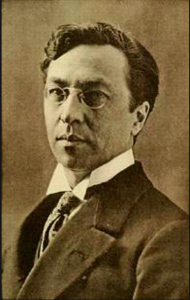
March 15, 2021
Dear Wassily Kandinsky,
My name is Isobel Williamson, and I’m a junior at the University of Washington studying International Studies and an avid fan of painting and art history. For my Honors “The Politics and Practice of Making: Art as a Tool for Creating Change” course this winter, I’m writing this letter to discuss the relationship between the purpose of making art for the creator as it relates to symbolism, the sensory experience, and social and political context. I also want to explore how technological progress has played into each of these themes and how your teachings are relevant in the modern day. I wanted to address you specifically because, after viewing some of your works in the Centre Pompidou on a trip several years ago, I was immediately struck by your use of color, shape, and composition, and how your paintings are so evocative of music and sound. Your art was incredibly resonant with me. I thought it would be only fitting that I compare and contrast our perspectives on the aforementioned themes and analyze your theories and teachings through the lens of my own lived experiences and modern-day context.
Regarding the purpose of art for the creator as it relates to symbolism and the sensory experience, one of the most prominent theories you developed is that art should be original and highlight the artist’s inner truth. You write, “That is beautiful which is produced by the inner need, which springs from the soul.”[1] I have interpreted your idea of “original” to mean “unlike anything else that has been created before because it is so authentic and personal to its creator.” You firmly argue that the most compelling works of art are the ones that are most personal. You also stated that artists should be prepared for others to misunderstand their work, and that abstract shapes are the most effective way to convey an artist’s inner truth. For example, many of your paintings, such as Composition 8, demonstrate your inner sensory world and your experience with synesthesia.[2]
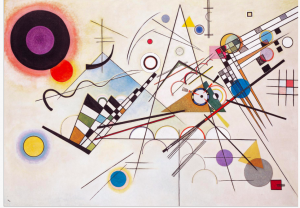
I believe that your teaching that the purpose of making art is to express inner truths is relevant today because, in the 21st century, we are constantly taking in huge amounts of information through social media, news, and other sources. Many sources we view are curated by algorithms that show us the content we are most likely to interact with. This means that much information we receive now does not challenge our beliefs and reinforces our preconceived notions. I believe that, from a modern-day perspective, we can learn from your idea that art should display the creator’s own truth, even though it will be more difficult for the audience to understand. I think that your teachings are especially important in the modern day because the act of slowing down to examine art and other content that is not designed to be extremely easily interpreted by its audience can be a powerful way of stretching our thinking and expanding our worldview. This is significant in broader context because the media we consume today can create an echo chamber around us and reinforce our own biases if we do not actively seek out information to challenge them. Additionally, I personally felt as though many of my classmates’ computer-aided design and textile projects that were symbolic, abstract, or metaphorical allowed me to gain great insight into their perspectives with some context. A major intention of yours was that more details and meanings in your paintings would be revealed to the audience as they expand their understanding of and connection to your work.[3] I think that your theories serve as a reminder to challenge ourselves to pause and conduct critical analysis of the content and media we view, rather than taking in everything at face value.
In contrast to your theories about art’s function for the maker and abstraction as the most effective means of conveying this purpose, I used concrete and recognizable symbols and images to make sure that an audience with little context would be able to understand the messages I wanted to convey through my making projects. As shown in the image below, the main component of my “Waiting” project was a mask stitched together from many quilt squares, which I embroidered with designs that clearly represent my experience waiting for quarantine to end: a house captioned with the words “CABIN FEVER,” a Zoom logo, and other distinct symbols. After conducting more research into your beliefs around the purpose of making art, I do agree with you that, the more abstract or symbolic I were to have worked, the more personal to me the project could have been, but the more open to misinterpretation my work would have been without context. While I did find that this project helped me convey my frustrations, anxieties, and upset, and a tiny bit of hope for the future, after reflecting more on your teachings I also believe that the process of making could have been perhaps more introspective for me if I were to have used more abstract or symbolic forms. Still, I believe that, given my intentions for this project: to be able to look back on it in many years and instantly be reminded of my experience during quarantine, my choice to work in more concrete symbols will jog my memory of these truths easier than abstract images.
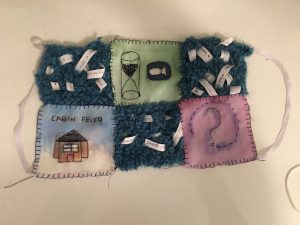
Something I found interesting is how differently we used art to respond to social and political phenomena that evoke themes of waiting and dread. For my time capsule project, I used computer-aided design software to display a collective truth, rather than an individual truth, around environmental deterioration due to mass production and the dread surrounding an impending ecological crisis. The clear symbols I included, especially the shape of the coffee cup and the logo, were designed to be easily interpreted as a call to action and creating more sustainable methods of production. Your final period of artwork, entitled the “Great Synthesis,” which incorporated concepts you developed in your Munich and Bauhaus periods, was informed substantially by your experiences of living through the Great Depression, the Russian Revolution, both World Wars, the and Bauhaus being shut down and your work confiscated by the Nazis [4] A theme throughout these paintings, especially your first ten compositions, is waiting for an apocalypse.[5] You created abstracted symbols for various Biblical characters and themes related to the feeling of impending doom in these compositions through color, shape, and paint techniques .[6] I believe that your individual artistic interpretations of this impending doom can be just as political as expressions of a collective experience. I believe that any personal art can reverberate politically in an impactful way, whether it tells of a collective or an individual truth. And I believe that abstract art is also important in a political and social context because the work the audience takes to analyze and interpret abstract art can mean that the overall meanings of an abstract piece stick with a viewer for a long time.
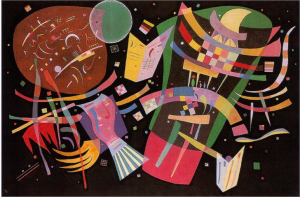
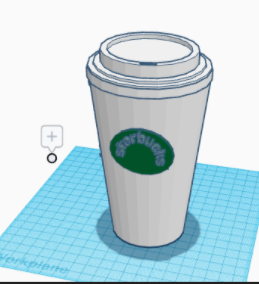
Next, I’d like to elaborate on the sensory experience of making and creating art and how this relates to technological progress. You use your art as a means of reconnecting with your own sensory world and displaying your experiences with synesthesia. In my “Waiting” project, I worked with sewing and other textiles and noted how time-consuming and detail oriented this process was. This project also very much forced me to reflect on my own bodily, temporal, and sensory experience of waiting. Because most of my life is now entirely online, and my perspective is so often literally limited to a computer screen, I found my waiting project very refreshing, as it is the first project I’ve done for school in a full year that has been more tactile, rather than entirely on the computer. This relates back to my earlier points about how many of your teachings can inspire a modern-day audience to slow down, process the world in more detail, and work to understand their own lived experiences and truths.
Would you have found technology such as computer-aided design programs, which allow exactness in terms of selecting shapes and colors, to support your teachings and your theories about the purpose of creating art? Or would you have considered these technologies a less authentic means of expression? From my own analysis, I believe that you may have considered these tools to be extremely helpful in the sense of creating and analyzing color theory and how colors relate to emotional expression, as many of your theories which involved examining the colors of lines and angles, required a great deal of precision.[7] Your “Several Circles” painting, with its exact shapes and very deliberate colors and composition, is an example of this attention to detail.[8] On the other hand, the process of learning how to use the CAD controls was relatively difficult for me, and I felt as though I did have a bit less influence over the final outcome than if I had done a drawing by hand. I also felt cut off from the tactile experience of making art during my time capsule project in comparison to my “Waiting” project. Ultimately, however, I believe that you would be enthusiastic about the incorporation of computer software into artistry if it helps artists create even more novel designs and express their inner truths in a way that is difficult to do otherwise. Furthermore, technology, especially platforms such as YouTube, has democratized arts education and allowed more people to share their work. By this metric, has technology allowed for a higher number of who you call “enlightened artists,” or artists who create the original and truthful works you emphasize?[9]
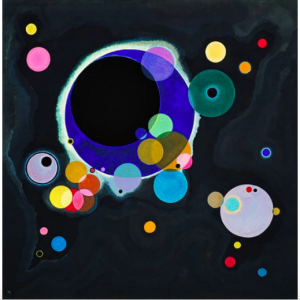
Another quote of yours from Concerning the Spiritual in Art that relates to the purpose of making art, symbolism, and the sensory experience that I found very interesting is,
“A painter, who finds no satisfaction in mere representation, however artistic, in his longing to express his inner life, cannot but envy the ease with which music, the most non-material of the arts today, achieves this end. He naturally seeks to apply the methods of music to his own art. And from this results that modern desire for rhythm in painting, for mathematical, abstract construction, for repeated notes of colour, for setting colour in motion.”[10]
I think this quote is worthy of mention because, in relation to technology, I wonder how having access to more video editing software would have influenced your art and legacy in combining the visual and the auditory sensory experiences. Google Arts and Culture has a feature called “Play a Kandinsky,” which allows audiences to hear the sounds associated with the shapes you painted. Would you used video editing software to express your synesthetic experience in addition to or in lieu of painting if you had access to it? Or do you think that this would have conveyed too much information to the reader and made it less worthy of closer examination? I believe that you may have thought that this software would provide too much immediate information to the viewer and given them less room to interpret your work for themselves.
One noteworthy thing I observed when using TinkerCAD is how the default colors for several shapes are very similar to the colors you theorized are associated with these shapes. I disagree with the aspect of your theory that the emotions that colors and shapes evoke are universal because different cultures have such different lexicons for colors and emotions. I think, however, that example this serves to demonstrate your legacy living on in technological programs built long after you were alive.


I’m left with a few questions for you, that have been difficult for me to find clear answers to in my own research: how did the amount of context you intended to give the audience of any specific pieces influence your desire to make the imagery more or less abstract? Finally, an overarching question I have touched on throughout this letter is, to what extent do you think that the 21st century technology I described impedes or amplifies our ability to express our truths?
In conclusion, as someone who also does have a few forms of synesthesia, including colored hearing, your art and expressions of your reality were easy for me to build a personal connection with. For me, the only way to truly express what my sensory experience is like to other people is through art, most often drawings and paintings, as verbal descriptions don’t quite do it justice, and I’m not yet talented enough at video editing. Learning that my own sensory perceptions are very different from most people’s’ was initially (and still sometimes is) jarring and surprising for me, but looking at your work reminds me of the importance of working to truly appreciate my way of viewing the world. I’ve most definitely felt self-conscious about this aspect of my identity and believed it more of a distraction and hindrance. Seeing you turn your synesthesia into art that is highly appreciated many years after you’ve lived has definitely served to validate my own experiences and help me work to accept and celebrate them as well.
For that, I would like to immensely thank you for your work. While I don’t agree with the specifics of all of your theories, your teachings can serve as valuable reminders to reconnect with our sensory systems during the coronavirus pandemic, as well as to make sure to take the effort to understand perspectives and media that are not our own.
Sincerely,
Isobel Williamson
Media Attributions
- Wassily Kandinsky © Anonymous adapted by Rückblicke. Berlin: Sturm Verlag. is licensed under a Public Domain license
- Composition 8 © Wassily Kandinsky adapted by © 2018 Artists Rights Society (ARS), New York/ADAGP, Paris is licensed under a Public Domain license
- Waiting Midterm Project: Quilted Mask © Isobel Williamson is licensed under a CC BY-NC-ND (Attribution NonCommercial NoDerivatives) license
- Screen Shot 2021-03-15 at 9.30.49 PM is licensed under a Public Domain license
- Starbucks Cup Time Capsule © Isobel Williamson is licensed under a CC BY-NC-ND (Attribution NonCommercial NoDerivatives) license
- Several Circles © Wassily Kandinsky adapted by Guggenheim Museum is licensed under a Public Domain license
- TinkerCAD Shapes © Isobel Williamson is licensed under a CC BY (Attribution) license
- Kandinsky, Wassily, 1866-1944. Concerning The Spiritual in Art. London :Tate, 2006. ↵
- Berry, Kenneth. "The Paradox of Kandinsky's Abstract Representation." Journal of Aesthetic Education 39, no. 1 (2005): 99-104. ↵
- Henry, Michel. Seeing the Invisible : On Kandinsky. London: Continuum, 2009. ↵
- Lindsay, Kenneth C. The Art Bulletin 64, no. 4 (1982): 678-80. Accessed March 16, 2021. doi:10.2307/3050290. ↵
- Najda, Aleksander. "Apocalypse According to Vasily Kandinsky." PhD diss., University of Illinois at Chicago, 2014. Najda, A., 2014. ↵
- Najda 2014 ↵
- Brooks, Deanna. "It Could Have Been Great: An Examination of Kandinsky's Bauhaus Paintings and the Great Synthesis of the Arts." (2016). ↵
- Dabrowski, Magdalena. "Kandinsky Compositions: The Music of the Spheres." MoMA, no. 19 (1995): 10-13. Accessed March 15, 2021. http://www.jstor.org/stable/4381285. ↵
- Kandinsky, Wassily, 1866-1944. Concerning The Spiritual in Art. London :Tate, 2006. ↵
- Kandinsky, Wassily, 1866-1944. Concerning The Spiritual in Art. London :Tate, 2006. ↵

